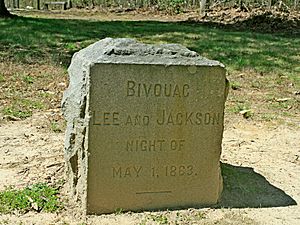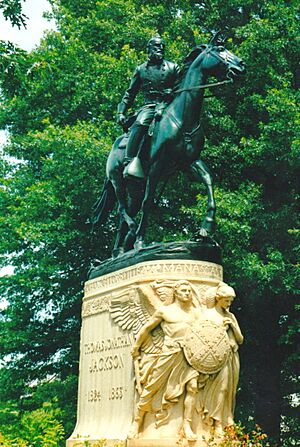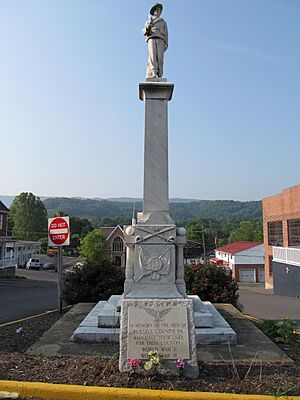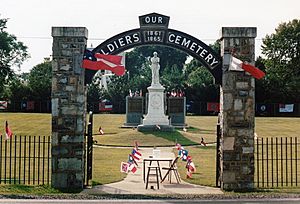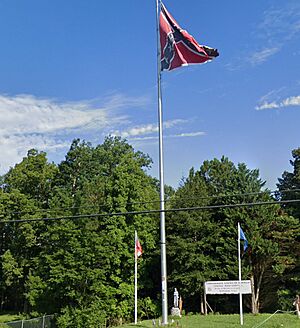List of Confederate monuments and memorials in Virginia facts for kids
This list of Confederate monuments and memorials in Virginia shows public displays and symbols of the Confederate States of America (CSA). These symbols honor Confederate leaders or soldiers from the American Civil War. They are part of remembering the Civil War. These symbols include statues, flags, special holidays, and the names of schools, roads, parks, and other public places.
This list does not include simple historical markers or battlefield parks. It focuses on symbols created to honor the Confederacy. As of June 2020, Virginia had at least 239 public spaces with Confederate monuments. This is more than any other state.
Contents
Places Named After Confederate Figures
Many places in Virginia are named after people or events from the Confederacy. This includes bridges, buildings, rivers, and highways.
Bridges and Buildings
- Abingdon: The John Hunt Morgan Bridge is named for a Confederate general.
- Richmond: The Robert E. Lee Bridge is named after the main Confederate general.
- Alexandria: The Robert E. Lee District RECenter was renamed Franconia RECenter.
- Lynchburg: Randolph College has the Terrell Health and Counseling Center. It was named for Confederate General Alexander W. Terrell.
- Manassas: The Stonewall Jackson Volunteer Fire & Rescue Department is named after General Stonewall Jackson.
- Richmond: The Hunter Holmes McGuire Veterans Administration Medical Center is named after Hunter Holmes McGuire. He was a Confederate doctor and supported the ""Lost Cause"" idea.
Rivers and Highways
- Rockbridge: The Maury River is named after Matthew Fontaine Maury. He was a Commodore in the Confederate navy.
- Many highways across Virginia were named after Confederate figures. Some examples include:
- Lee Highway, named after Robert E. Lee.
- General Mahone Highway, a large part of U.S. Route 460.
- Jefferson Davis Highway, named after the Confederate president. Some parts have been renamed.
- Jubal Early Highway, named after General Jubal Early.
- John Mosby Highway, named after a Confederate colonel.
- Stonewall Jackson Highway, named after General Stonewall Jackson.
- Magruder Boulevard was renamed Neil Armstrong Parkway in 2021.
Public Monuments and Statues
Many towns and cities in Virginia have monuments honoring the Confederacy. These can be found in front of courthouses or in public parks.
Courthouse Monuments
Many counties in Virginia have Confederate monuments near their courthouses. These were often put up in the early 1900s. Some examples include:
- Abingdon: Confederate Monument (1907).
- Amelia: Confederate Monument (1905).
- Appomatox: Confederate Monument (1905).
- Eastville: Confederate Monument (1913). It was put up by Confederate veterans and citizens. The monument honors soldiers from Northampton and Accomack Counties. It says they "died bravely in war, or, in peace live nobly to rehabilitate their country."
- Pearisburg: Confederate Medal of Honor Monument (1995). It has a quote from Jefferson Davis about teaching children about their ancestors.
- Winchester: Confederate Soldiers Monument (1916). It honors Confederate soldiers from Winchester and Frederick County.
Other Public Monuments
- Alexandria:
- Plaques of Robert E. Lee and George Washington were at Christ Church. The church decided to remove them in 2017.
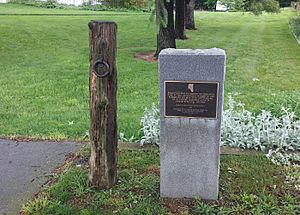
- Berryville: A memorial (1986) marks where Robert E. Lee tied his horse, Traveller. This was when Lee paused on his way to Gettysburg.
- Brandy Station: A monument (1998) honors John Pelham.
- Chancellorsville: Several monuments are at the site of the Battle of Chancellorsville. These include:
- Jackson Memorial Boulder and Tablet (1888), placed by General Stonewall Jackson's staff.
- General Thomas J. Jackson Shaft (1888), marking where he was mortally wounded.
- Lee-Jackson Bivouac Shaft (1903), marking where Lee and Jackson camped.
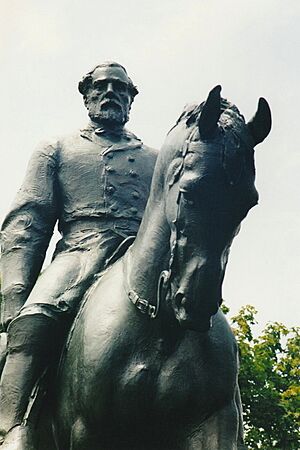
- Charlottesville:
- The Robert Edward Lee statue (1924) and the Thomas Jonathan ("Stonewall") Jackson statue (1921) caused much discussion. The city council voted to remove them. This led to protests and legal challenges. The statues were covered in black for a time. The parks where they stood were also renamed.
- University of Virginia Cemetery: A Confederate monument (1893) is here.
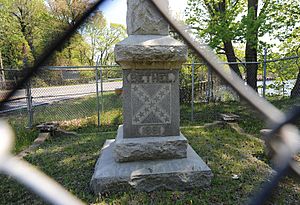
- Hampton:
- Two monuments are at Big Bethel Cemetery, inside Langley Air Force Base.
- Hampton National Cemetery: Two small blocks honor "Our Confederate Dead."
- Lebanon: Confederate Monument (1914).
- Lexington:
- Francis H. Smith Confederate Monument (1931).
- Stonewall Jackson Monument and Arch.
- Washington and Lee University: This university was renamed after Robert E. Lee. A large marble statue of Lee is inside Lee Chapel. Lee is buried there. His horse, Traveller, is also buried nearby.
- Virginia Military Institute: Has a statue of Francis H. Smith (1931). It also has Virginia Mourning Her Dead (1903), honoring cadets who died in battle. A Stonewall Jackson Monument and Arch (1912) is also present.
- Mount Jackson: "Our Soldiers Cemetery" statue (1903).
- Orange County: The Wilderness Battlefield has several Confederate monuments. These include:
- Wilderness Battlefield Tablet (1927).
- Texas Brigade Shaft (1964), marking where Texans fought.
- "Lee to the Rear!" Tablet (1903), remembering a famous moment in battle.
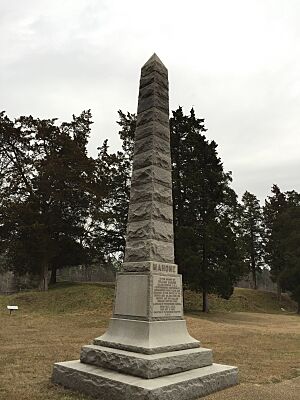
- Petersburg:
- Petersburg National Battlefield has monuments like Hagood's Brigade and Old Men and Boys Monument.
- Mahone Monument (1927) at the Battle of the Crater.
- Monuments mark where generals A. P. Hill and John Pegram were killed.
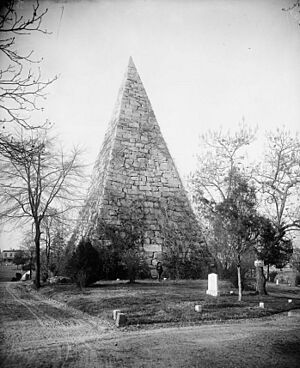
- Richmond:
- A.P. Hill Monument (1892).
- Confederate Soldiers and Sailors Monument (1894) at Libby Hill Park.
- Hunter Holmes McGuire statue on Capitol Square.
- The Memorial Granite Pile in Hollywood Cemetery.
- Monument Avenue once had several large monuments to Confederate leaders. In 2020, Governor Northam ordered the Robert E. Lee Monument removed. The city council also supported removing the other monuments. The Lee statue was removed in September 2021.
- Roanoke: The Roanoke City Council voted in 2020 to remove the Robert E. Lee Memorial.
- Wilderness: A monument (1903) marks where Stonewall Jackson's amputated arm was buried.
- Winchester: Stonewall Confederate Cemetery is a section of Mount Hebron Cemetery. It has a monument to the Unknown and Unrecorded Dead (1879).
Private Monuments
Some Confederate monuments are on private land.
- Blairs: A very large Confederate flag is near U.S. 29.
- Franklin County: The Jubal A. Early House is the childhood home of General Jubal Early.
- Harrisonburg: The Turner Ashby Monument (1898) is on Turner Ashby Lane. It has been vandalized several times.
- Petersburg: The former Blandford Church was turned into a Confederate memorial.
- Templeton: A large Confederate Battle Flag and other flags are part of the Army of Northern Virginia Memorial Flag monument.
Parks and Roads Named After Confederate Figures
- Fort Monroe: Jefferson Davis Memorial Park (1956) honors the Confederate president's time imprisoned there.
- Roanoke: Lee Plaza was renamed Freedom Plaza in 2020.
- Many roads across Virginia are named after Confederate generals or events. These include:
- In Alexandria: Beauregard Street, Jackson Place, Lee Street, and Longstreet Lane.
- In Fairfax: Confederate Lane, Mosby Woods Drive, and Pickett Road.
- In Richmond: Confederate Avenue and Mosby Court.
- In Virginia Beach: General Beauregard Drive, General Jackson Drive, and General Lee Drive.
Schools Named After Confederate Figures
Several schools in Virginia were named after Confederate figures.
- Bridgewater: Turner Ashby High School is named for CSA colonel Turner Ashby. Their sports teams are called the "Black Knights."
- Bristol: Stonewall Jackson Elementary School and Washington-Lee Elementary School.
- Fairfax: Lees Corner Elementary, named for the Lee family.
- Henrico: Douglas S. Freeman High School. Its sports teams are nicknamed the "Rebels."
- Hurley: Hurley High School. Its sports teams are also called the "Rebels." Confederate symbols are common at the school.
- Lexington: Washington and Lee University.
- Mathews: Lee-Jackson Elementary School.
- Montross: Washington and Lee High School.
- Stuart: Stuart Elementary School (1938).
Former or Removed Monuments and Memorials
Many Confederate monuments and memorials have been removed or renamed in Virginia. You can find a list of these changes in the article Removal of Confederate monuments and memorials#Virginia.
See also
- Virginia in the American Civil War
- List of Confederate monuments and memorials
- List of memorials and monuments at Arlington National Cemetery
- Removal of Confederate monuments and memorials#Virginia


